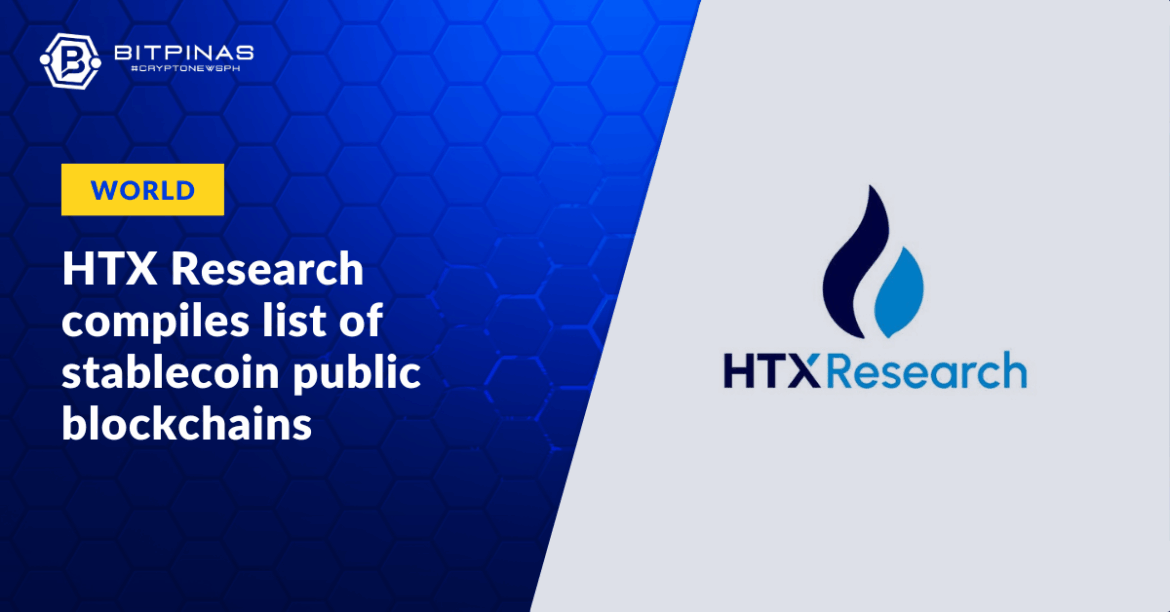Disclaimer: This article is for informational purposes only and does not constitute financial advice. BitPinas has no commercial relationship with any mentioned entity unless otherwise stated.
📬 Get the biggest crypto stories in the Philippines and Southeast Asia every week — subscribe to the BitPinas Newsletter.
A new report from HTX Research, the research division of crypto exchange HTX, identified the rise of a new category of blockchain networks built specifically for stablecoin payments and settlements, known as “stablecoin public blockchains.”

What Are Stablecoin Public Blockchains?
According to HTX Research, these networks integrate stablecoin issuance, cross-chain transfers, compliance checks, and application development directly into their infrastructure.
Unlike general-purpose blockchains such as Ethereum or Solana, which host a wide range of decentralized applications, stablecoin public blockchains focus solely on fast, low-cost, and compliant financial transactions.
They allow users to pay fees directly in stablecoins instead of volatile native tokens. Moreover, these blockchains are designed to support real-world financial activities such as cross-border remittances, payroll distribution, and trade settlements.
Stablecoin public blockchains also feature built-in compliance modules for KYC and AML requirements, along with privacy options for sensitive data.

List of Stablecoin Public Blockchains
Arc
Arc is Circle’s first native public blockchain and serves as a dedicated settlement layer for its stablecoin, USDC.
- Designed to deliver predictable transaction fees and low latency, Arc can process up to 3,000 transactions per second (TPS) with sub-second confirmation times.
- The network uses USDC as its native gas token, eliminating the volatility risk of traditional blockchain fees.
- It also integrates Circle’s Cross-Chain Transfer Protocol for USDC movement across networks and features built-in foreign exchange modules for on-chain currency swaps.
The research stressed that privacy and compliance functions are embedded in the system, which allows regulated institutions to operate securely while maintaining selective transaction visibility for auditors and regulators.
Tempo
Developed by payments company Stripe in partnership with crypto investment firm Paradigm, Tempo is a payments-first blockchain designed to serve Stripe’s network of merchants.
- It aims to achieve up to 100,000 TPS with sub-second confirmation times, positioning it among the fastest stablecoin networks in development.
- The platform allows multiple stablecoins to be used as gas and integrates an automated market maker for stablecoin swaps.
- Tempo also connects directly to fiat payment rails, enabling instant conversions between digital and traditional currencies.
- Tempo is designed to connect to fiat payment rails and has tested integrations to enable seamless conversion between digital and traditional currencies.
- Currently operating with a consortium-like validator model, the network shared its plans to expand toward greater decentralization as adoption grows.
Stable
Launched jointly by USDT issuer Tether and crypto exchange Bitfinex, Stable is an EVM-compatible Layer 1 blockchain that serves as the main venue for USDT transfers.
- Built using a consensus mechanism called StableBFT, the network supports up to 10,000 TPS and second-level finality.
- Transaction fees are paid directly in USDT, and peer-to-peer transfers can be gas-free through account abstraction.
- Stable includes enterprise-focused tools such as batch transfer aggregation, compliant-private transfers, and on-chain settlement systems for cross-border clearing.
According to the HTX Research, the project raised $28 million in seed funding, backed by institutional investors including Franklin Templeton, and plans to expand with fiat on- and off-ramp integrations, debit card issuance, and business payment solutions.
Plasma
Plasma is a Bitcoin sidechain optimized for USDT payments; it combines Bitcoin’s brand recognition with the flexibility of EVM compatibility.
- It uses a custom consensus mechanism, PlasmaBFT, which delivers high throughput and enables zero-fee USDT transfers.
- Users can choose between public and private transaction modes, making it suitable for both consumer payments and institutional settlements.
- Plasma also supports a non-custodial BTC bridge, allowing the asset to flow directly into the EVM ecosystem
- Plasma also supports a non-custodial BTC bridge, enabling BTC to be wrapped and used within the EVM-compatible stablecoin ecosystem.
Converge
Converge is a Layer 2 blockchain on Ethereum jointly developed by DeFi protocol Ethena Labs and tokenization platform Securitize, designed to connect real-world assets (RWAs) with DeFi.
- It uses Arbitrum’s execution stack with Celestia for data availability, powered by a Conduit-driven custom sequencer that achieves 100-millisecond block times and high throughput.
- The network supports stablecoin-based gas payments using assets like USDe and USDtb and provides institutional-grade custody through partners such as Anchorage, Fireblocks, and Copper.
As per the report, Converge collaborates with Hamilton Lane, Aave, and Pendle to enable large institutions to trade RWAs, bonds, and tokenized funds on-chain in a regulated environment.
Codex
Backed by venture firm Dragonfly, Codex is an enterprise-focused Ethereum Layer 2 blockchain built using the OP Stack framework.
- It targets corporate stablecoin payments, payroll processing, and trade finance settlements.
- Codex features gas abstraction mechanisms that allow predictable transaction costs and integrates on-chain FX settlement and custody capabilities for multi-currency operations.
- Final settlements occur on the Ethereum mainnet to ensure auditability and security.
- Final settlements occur on the Ethereum mainnet to guarantee secure finality and auditability.
The report noted that since its mainnet launch in mid-2024, Codex has raised $15.8 million and partnered with Circle Ventures, Coinbase, Cumberland, and Wintermute to expand its enterprise financial infrastructure.
What Are Stablecoins?
Stablecoins are a type of cryptocurrency designed to maintain a stable value by pegging their worth to traditional assets such as the U.S. dollar, Philippine peso, or commodities like gold.
Unlike BTC or ETH, which can experience significant price fluctuations, stablecoins aim to offer price consistency, which makes them useful for everyday transactions, remittances, and as a store of value.
There are several categories of stablecoins.
- Fiat-backed stablecoins, such as USDT and USDC, are backed by reserves held in banks or financial institutions.
- Algorithmic stablecoins rely on complex mechanisms and smart contracts to maintain their peg without holding actual reserves.
- Crypto-backed stablecoins are pegged to and reserve an equivalent cryptocurrency like BTC or ETH.
Locally, several Philippine-peso-pegged stablecoins have emerged since 2019, led by banks, fintech firms, and crypto communities aiming to improve remittances, payments, and financial inclusion, though many projects remain in early stages or lack recent updates.
Notable initiatives include PHX by UnionBank, PHPC by Coins.ph, and PUSO by Celo DAO, with varying degrees of regulatory engagement and blockchain integration.
This article is published on BitPinas: List of Stablecoin Public Blockchains
What else is happening in Crypto Philippines and beyond?


